My project was to replicate King Tut’s mask and adapt it to today’s society. The beautiful and intricate mask of King Tut was designed in the image of the pharaoh and was intended to assist the king’s spirit in its transition to the afterlife. In addition to ensuring that the soul was able to recognize its own body, the burial mask transformed mortals to a godly state and allowed them to pass safely through the underworld. King Tut’s mask weighs about 25 pounds and stands about 2 feet tall. This priceless treasure is composed of a solid gold base inlaid with semi-precious stones such as lapis lazuli, obsidian, and quartz. The face of the mask, meant to be a likeness of King Tut, is made of a smooth, radiant gold. Ancient Egyptians associated gold with the sun god, Ra, and considered it to be a powerful material for aiding pharaohs in their journey to the afterlife. Sitting atop the pharaoh’s head is a traditional headpiece made of gold with bright blue stripes of lapis lazuli. In addition to the striking blue stripes, the headpiece features both a rearing cobra and a vulture. Known together as the “two ladies of the pharaoh”, these figures would have served a dual purpose of protecting the pharaoh from those who might oppose him and symbolize the king’s power over both Upper and Lower Egypt. Notable rings of lapis lazuli encircle the eyes of King Tut’s mask. Elaborate eye makeup was a standard for Egyptian royalty, as it created the almond eye shape which was considered desirable. One of the most notable features of King Tut’s mask is the long, narrow golden beard. False beards similar to the one on the mask would have been worn by the pharaoh as a symbol of his position as a living god and divine being. Coupled with the false beard, the crook and flail crossed over the chest would have emphasized the relationship between Osiris, lord of the underworld, and the spirit of the deceased pharaoh. Spells for protection and guidance from the ancient Egyptian Book of the Dead are carved into the back and shoulders. My replication contained a few changes, such as painting King Tut a beard/moustache. The reason I did this was to make King Tut appear masculine. Yet it was kind of a failure. King Tut ended up appearing cross gendered. Which I guess can represent today’s society’s willingness to accept the LGBTQ community and further more. Being exposed to King Tuts mask as a kid always left the idea in my head that King Tut was a female. In the original mask King Tut has very feminine features. Adding a beard to my replication was my way of making it more masculine. Another reason I wanted to recreate King Tut’s mask is that when it was first created it was created with gold and very expensive jewelery that is hard to find on a day to day basis. Creating this project with just paint and paper was very interesting and it looked super close to King Tuts original mask. The art project was very fun!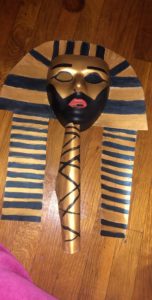
Posts
Final Project: Annotated Bibliography
- “Expressionism Movement, Artists and Major Works.” The Art Story, https://www.theartstory.org/movement-expressionism.htm
The Art Story was my introduction to the expressionism movement. I learned about its origin, key ideas behind the movement, and some of the artists who inspired the movement. What was also very useful was the three examples of some of the most famous expressionism artwork. I’ll be using this as background and base my three paintings off their examples.
Final Project: “The Influence of Expressionism in Social Movements” Paper Proposal
Expressionism was a movement that emerged in Germany during the early 20th century. It began as a defiant response to the conventional artistic Impressionist technique, where the depiction of reality was an objective one. Expressionist artists sought out to portray the world through a subjective reality, where their work depicted an emotional experience rather than the mere impression of one. They accomplished this through distortion and exaggeration of objects and events. The arrival of Expressionism announced new standards in the creation and judgment of art; “Art was now meant to come forth from within the artist, rather than from a depiction of the external visual world,” meaning the emotion within the artist was the most important material needed for their piece (The Art Story). As time progressed so did expressionism. Around the late 1940s, another movement called abstract expressionism emerged in New York. Within abstract expressionism were two broad groups: the action painters, who struck their canvases with powerful brush strokes; and the color field painters who were monochromatic painters. The abstract expressionists derived not only from expressionism but surrealism as well. Influenced by the emotion, “Abstract Expressionist painters rejected representational forms, seeking an art that communicated on a monumental scale the artist’s inner state in a universal visual language” (Khan). Following abstract expressionism came neo-expressionism during the late 1970s. This movement also rejected the standard composition and design and communicated a sense of inner disturbance, tension, and alienation. It was characterized as having expressive brush strokes, highly textured painting with paint built up on the canvas’s surface, and intense colors and most importantly always being focused on the controversial. Each of these movements gave many artists the freedom to express their reactions and emotions and allowed them to present the world from a subjective perspective enabling them to further create styles in which they can be more inventive and abrupt toward social injustices.
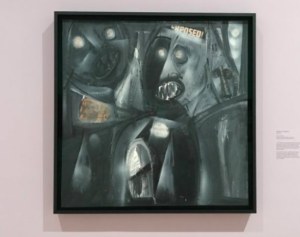
One of the many artists who was influenced by the expressionist movement was the abstract expressionist painter, Merton D. Simpson. In 1965 he created U.S.A. ’65, a piece in which he used newspapers that negatively portrayed African Americans and incorporated them into his work. The reason that I chose Simpson’s piece was due to his dark and monstrous faces. As an abstract expressionist, your emotions regarding a particular subject must be the main attraction and as for Simpson’s U.S.A. ’65, his emotions regarding the subject are very clear. Not just in the sense of his colors but his overall message of struggle and turmoil shines in his piece.

Faith Ringgold is another abstract expressionist painter who documented social discrimination. In her piece American People Series #20: Die we can see different races and both genders trying to kill each other, however, we can see that she dressed everyone the same. In doing so she shows the viewer, “an abstraction about what the fights were really all about… fighting to retain their position in society,” everyone is dressed equally to show they are all on the same level but there will also always be people who won’t let that happen. Through this style of art, Ringgold was able to speak up and tell the viewer a story and not be limited by anything (MoMA). This not only shows the reader what she physically sees but how she felt as she watches undocumented riots like these happen. American People Series #20: Die is a perfect example of the influence abstract expressionism can have on social movements.
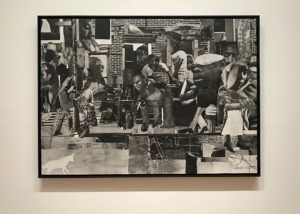
The last artist is Neo-expressionist, Romare Bearden. In his college called The Dove Romare uses various pictures from magazines, newspapers, and photographs to create something, unlike the previous two artworks. His use of all these elements are arranged in a way that the viewer’s eye is constantly on the move, jumping from light areas to dark areas and from pattern to pattern. In a time when society was divided Romare found a way to use his art to bring people together, figuratively and by literally placing people he found from different parts of the word in his artwork. At first glance, it may not seem as though it flows as well as the other paintings but that’s the beauty of Neo-expressionism, it wasn’t meant to follow conventional standards even within the expressionist movement.
Expressionism was a way for artists to convey more than a simple impression of a subject. This movement challenged them to dig deep within themselves and express their emotions, which in its self can be one of the hardest things to do. Expressionism provided artists with the tools they needed to speak up about social issues and along with their distorted images, helped evoke emotions and ideas within others.
Bibliography
Final Project: Paper Proposal Outline
Topic Question: How did Expressionism influence artists during Social Movements?
Thesis Statement: The Expressionist movement allowed artists to present the world from a subjective perspective enabling them to further create styles that allowed them to be more inventive and abrupt toward social injustices.

ARTIST: Merton D. Simpson
TILE: U.S.A ’65
DATE: 1965
MUSEUM: Brooklyn Museum

ARTIST: Faith Ringgold
TITLE: American People Series #20: Die
DATE: 1967
MUSEUM: MoMA
 ARTIST: Romare Bearden
ARTIST: Romare Bearden
TITLE: The Dove
DATE: 1971
MUSEUM: MoMA
These five brilliant pieces of artwork all have one thing in common; they are all part of the expressionism movement. In each painting, there is a unique perspective being shown using styles like abstract expressionism or neo-expressionism. Breaking away from accepted conventions, artists were able to distort the world in a radical way for emotional effect. Looking at paintings like “U.S.A ’65” and “Emergency Room” not only shows us what the artist thought of society at the time but it also makes us reflect as to where society might be heading if we continue down a path of discrimination.
MET Museum Visit
Throughout this semester I have visited the Metropolitan Museum. I honestly really liked going to the Metropolitan Museum compare to the Brooklyn Museum. As I walked in the entrance, I saw lots of people walking around the area. People were talking among themselves very loudly. The museum was huge and wide that I feel like people would easily get lost. I can imagine how many people going in and out of the museum every day. During that day, the weather was extreme cold, and I saw lots of people waiting outside patiently for the door to open. I saw students from school coming to visit the museum.
I also have wondered what exactly are the Buddha made out of. Do people actually believe this religious Buddha? Why is Buddha very famous in the spread throughout other countries? What are there unique design compare to others?
However, as I observe around I saw many greats things. Such as, different culture paintings, nice sculptures, pottery, photograph, drawings, costumes, and so much more. What I liked about the museum was the Asian art which was consist of the Chinese, Japanese, and the Korean sculpture. I just like how the design was look and very outstanding. I find that these three countries has its unique and similarities difference between them.
Each of the sculpture has its own way to model and how it is presented to the audience. For example, as a Chinese culture, my family believe these Buddhisms. We would go to the Chinese temple and pray, we show our belief and respect to them The belief that there is an afterlife and not everything ends with death, that Buddha teaches people how to follow a successful path, how to be a good human being and do good things.
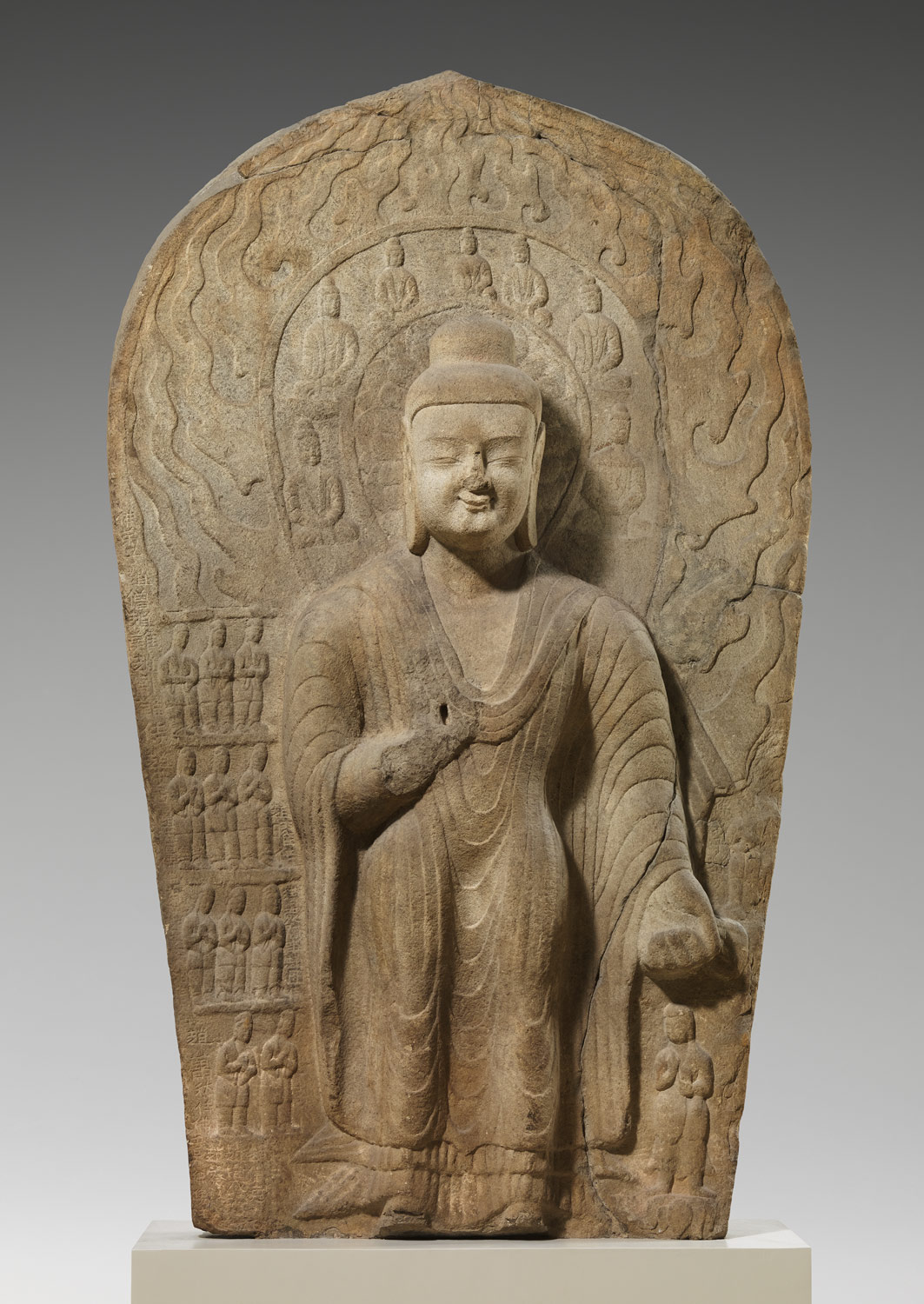
CHINA
This sculpture name the Buddha Dipankara (Diguang) it was during the period of the Northern Wei Dynasty around 386 to 534 years. Made with Sandstone with traces of pigment. This imagery represent the promise or possibly of enlightenment in a future life.
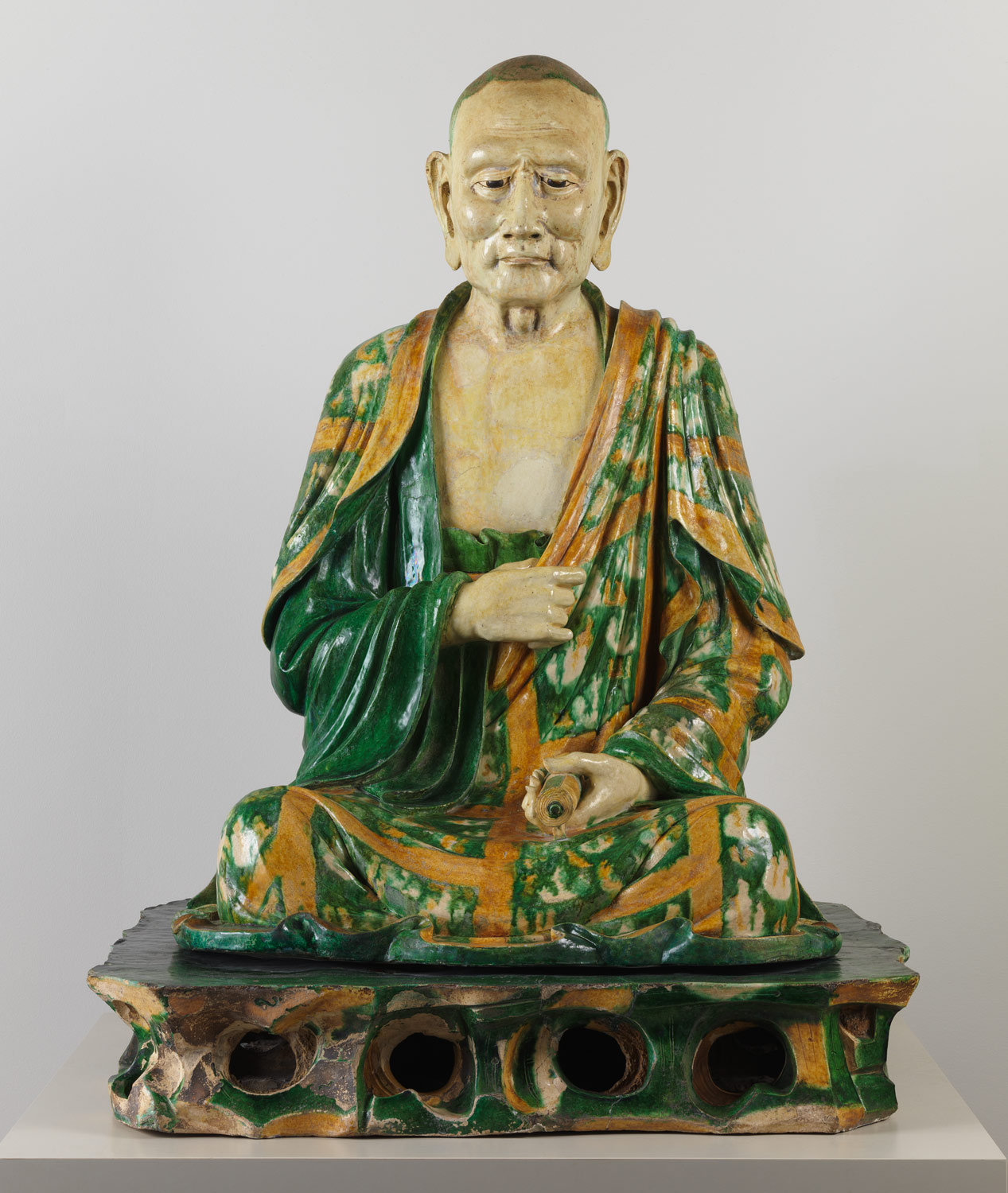
CHINA
This image is called the Arhat (Luohan) during the period of Liao dynasty from 907 to 1125. It was made out of the stoneware with three-color glaze. It describe the achieved spiritual development and how the Buddhism is being protected.
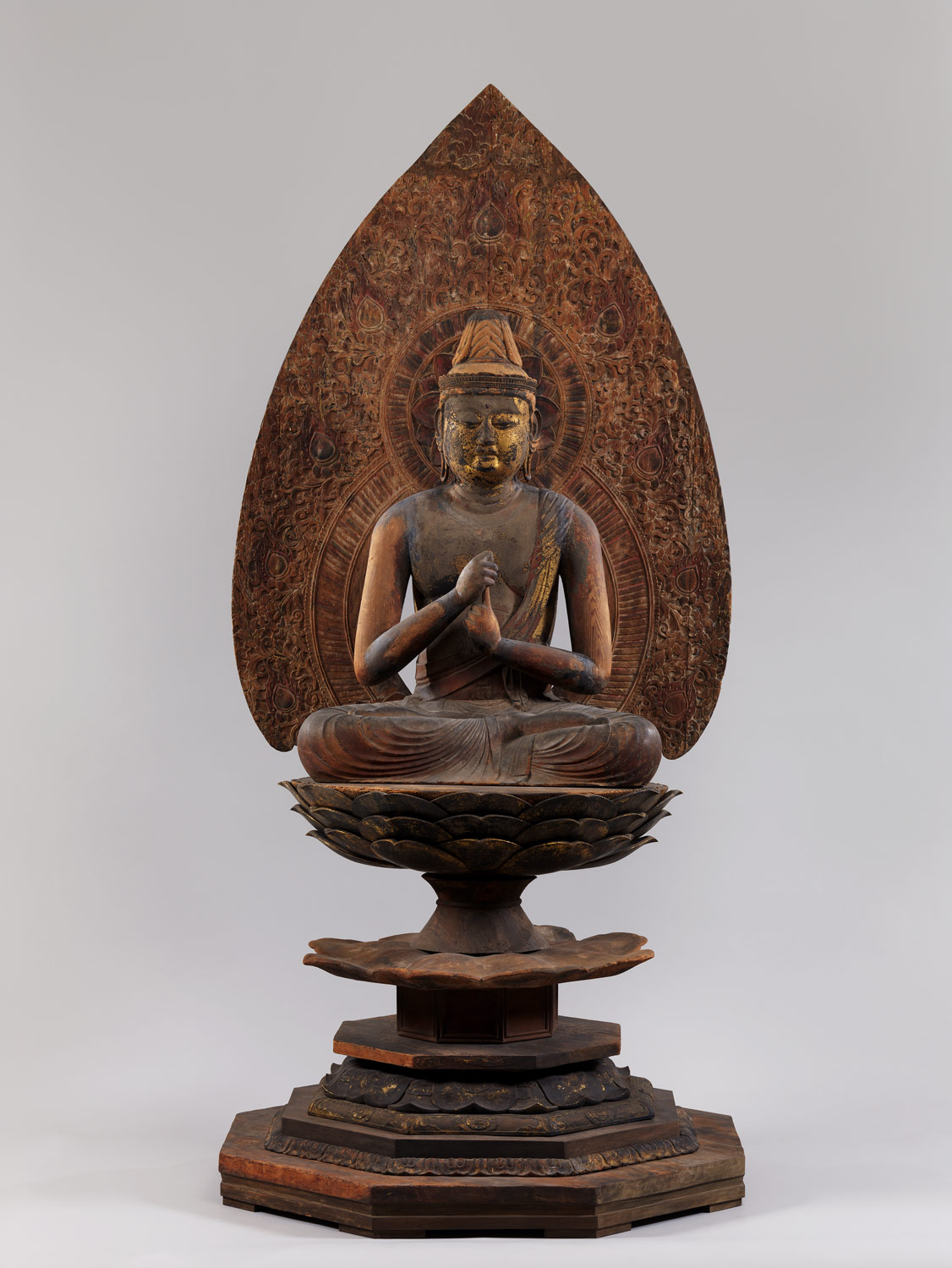
JAPAN
This model is name the Dainichi Nyorai during thr Heian period around 794 to 1185 years. This was made out of wood with gold leaf and lacquer decoration.

KOREA
This image is called the Kashyapa during the Joseon dynasty during the 1392-1910. Made out of wood with polychrome paint. His smiling face and relaxed posture convey benevolence and wisdom.
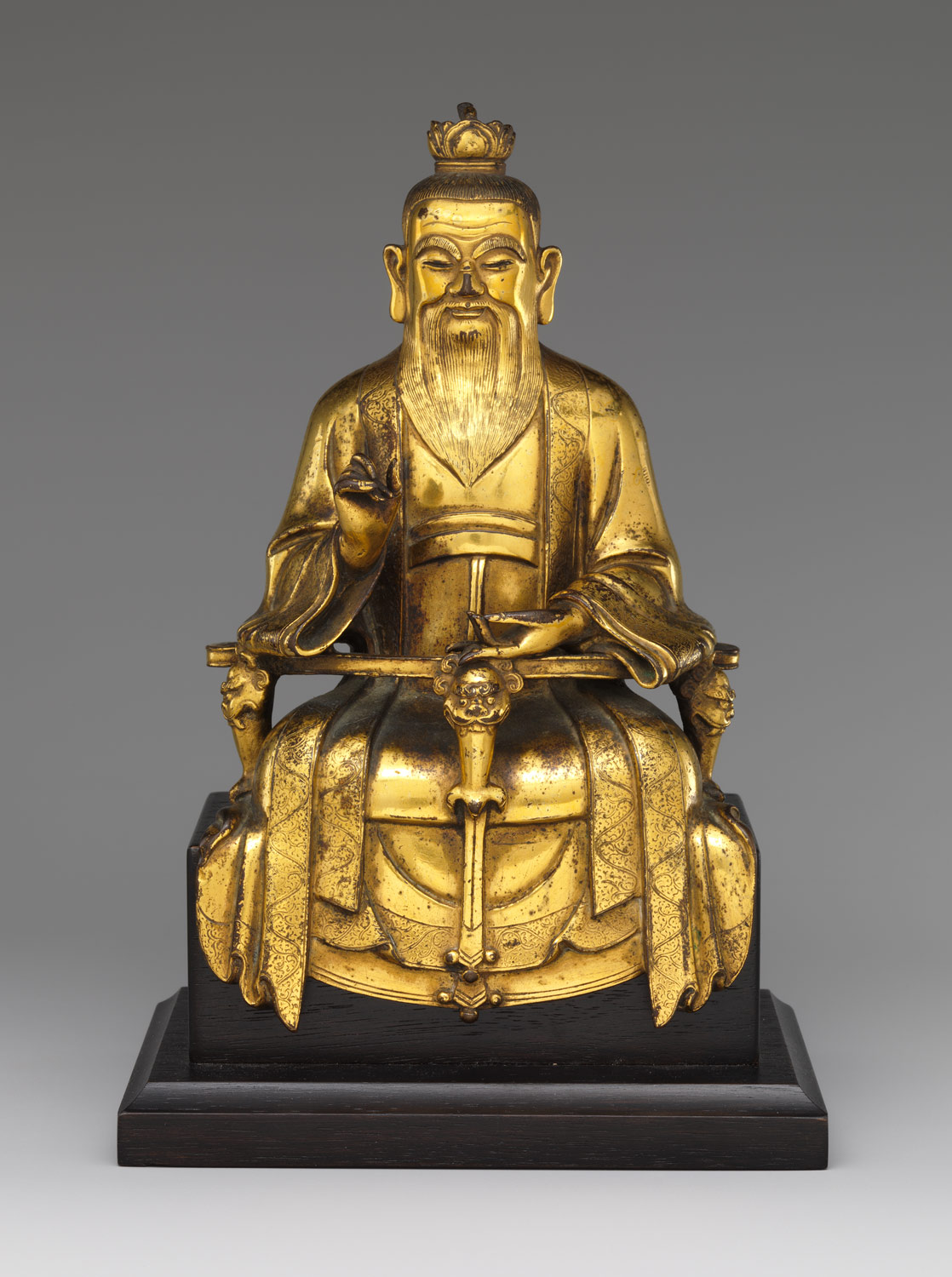
CHINA
This sculpture is named the Dadaist immortal Laozi during the Ming Dynasty around the 1363-1644 years. Made out of the gilt brass and lost wax. Spread throughout Daoism which was a major religion in China. It was define of beliefs and practices that helps guide for everyday life.
Lastly, I can say that China and Korea has a similarities kinds of sculpture between them. For example, the colors that makes it stands out, structure, forms, and lines. This relate to the lecture from the beginning of the semester. Talking about what is ART and what actually does ART show us. How do they interact with our society.
The Met Museum Visit
The art styles of Baroque and Renaissance has similarities but also many differences. The Renaissance time period began about 1300 A.D. and the Baroque time period started immediately after at about 1600 A.D..
The main and major difference between the two genre’s of art is the formations of lines and angles within the piece. Renaissance has straight and distinguishable lines while Baroque has curved and ‘messy’ lines.
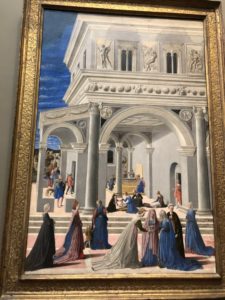 This Renaissance piece “The Birth of the Virgin” (1467), is a good example of straight lines and posing. The woman who just gave birth is posing in her bed and doesn’t seem natural. The painting in its entirety seems to be a posed, stiff moment. Even the baby, who is getting washed up, is standing straight and being posed. This painting is very unrealistic and stiff. It almost seems like the body movements are fake. The baby and children are deciphered as short adults.
This Renaissance piece “The Birth of the Virgin” (1467), is a good example of straight lines and posing. The woman who just gave birth is posing in her bed and doesn’t seem natural. The painting in its entirety seems to be a posed, stiff moment. Even the baby, who is getting washed up, is standing straight and being posed. This painting is very unrealistic and stiff. It almost seems like the body movements are fake. The baby and children are deciphered as short adults.
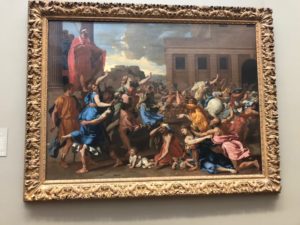 This Baroque piece, “The Abduction of the Sabine Woman” (1633-34), shows the drama and interactiveness of the Baroque period. You can’t tell where one body begins and another one ends. All the lines are curved, the hand, legs and bodys of the people are curved as if they are doing yoga while fighting or something. The babies look and act like what they are supposed to be; babies.
This Baroque piece, “The Abduction of the Sabine Woman” (1633-34), shows the drama and interactiveness of the Baroque period. You can’t tell where one body begins and another one ends. All the lines are curved, the hand, legs and bodys of the people are curved as if they are doing yoga while fighting or something. The babies look and act like what they are supposed to be; babies.
Final Project: The Importance of Realism
 Loading...
Loading...
Final Project
Final Project- Creative Project
For my creative project, I have decided to make a piece inspired by the abstract expressionist artist, Jackson Pollock. Jackson Pollock was known for his drip paint style pieces that at first glance may just seem like random splatter on canvas, but in reality, these pieces were so much more. The movement was a direct result of the Post-World War 2 world where the world was somehow even more unstable than before.According to the Museum of Modern art, the abstract expressionist movement was born in the 1950s when “the spirit of optimism had morphed into a potent mix of power and paranoia,” this due to the Cold War and fear of communism spread by the McCarthy hearings (Abstract Expressionism, Museum of Modern Art). Like I stated before, these paintings are so much more because they belong to a movement in which there is a “direct relation to the artist’s emotions, expression, and mood, and showcased their feeling behind the pieces they designed” (Jackson Pollock and his Paintings, Jackson-pollock.org). This personal connection to the painting also allowed for artists to be non- objective and explore new unorthodox techniques to fulfill their emotional needs rather than to make a painting with a specific audience (other than themselves) in mind. Along with the emotional connections formed by the artist and their canvas, there are also technical aspects that make a painting an abstract expressionism piece such as “physical engagement with his materials welcomed gravity, velocity, and improvisation into the artistic process,” ensuring the current feelings of the artist are correctly translated into the canvas (Jackson Pollock, Museum of Modern Art).
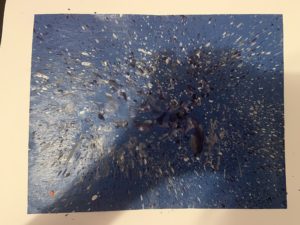
My creative Project
At first, while researching Jackson Pollock and abstract expressionism I believed that creating my painting would be easy and effortless, but I was wrong. Many factors went into creating a piece that I was satisfied with including materials, colors, color combination, texture, and the use of negative space. In the beginning, I had to choose between using paint, nail polish, oil pastels, or crayons, and finally chose crayon. I had chosen Crayon because abstract expressionism artists used unconventional materials, Pollock using house paint, and I had believed that crayons and a blow dryer were unconventional materials. The use of crayon in my piece would also add some texture to it. After choosing crayons, I tested how melting crayon would react on paper and to my surprise, they actually did go together. I also learned to create the piece I wanted to create I had to control the crayon’s splatter as much as possible by positioning the crayon and blow dryer at a perfect angle and distance from the paper. On my first version, I melted the crayons one by one but it proved ineffective as the melting the crayon would also start to melt the already dried wax on the paper. On my second try, I chose a different color from the first failed piece of yellow, dandelion, orange, and green to pink, orange, and red. My second piece (first successful piece) was completed, but I was unsatisfied with the end result and the abundance of white negative space. My third and present version was like its second version, completely different from its predecessor, the paper was now painted completely in a darker and grayer Blue, the crayon colors where now black, dark purple, white, and gray, and the direction the crayons were melted was in a clockwise direction instead of diagonally towards the top left corner. My third version was my best one because I was able to add more elements that made the piece more well-rounded as well as staying true to the origins of the abstract expressionist and Jackson Pollock painting by connecting with my canvas and capture my state of mind and feeling (mostly fear and anxiety) into the piece.
Works cited
“Abstract Expressionism”, Museum of Modern Art, https://www.moma.org/learn/moma_learning/themes/abstract-expressionism/
“Jackson Pollock and his Paintings”, Jackson Pollock
Biography, Paintings, and Quotes, https://www.jackson-pollock.org/
“Jackson Pollock”, Museum of Modern Art, https://www.moma.org/artists/4675
“Abstract Expressionism”, The Metropolitan Museum of Art, https://www.metmuseum.org/toah/hd/abex/hd_abex.htm
“Abstract Expressionism”, The Art Story Modern Art Insight, https://www.theartstory.org/movement-abstract-expressionism.htm
Final Project – Option 1
Themed Museum Tour – Final Project.
Good morning Ladies & Gentleman, I am Naomi and I will be your tour guide for today. If you are apart of this tour today it is because you have taken a special interest in emotions depicted in different forms of art. Throughout history, forms of art have successfully represented emotions and stories in different ways. We see emotions and stories further deepened in details like body language, facial expressions and symbolism. The MET is filled with so much history and beauty. I hope you all enjoy and appreciate the pieces I have selected for you. This tour will be about thirty to forty-five minutes long with an included bathroom break. The MET is a huge building, and it can also be crowded, be sure to stay close to not miss a thing. If you have any questions, feel free to ask.
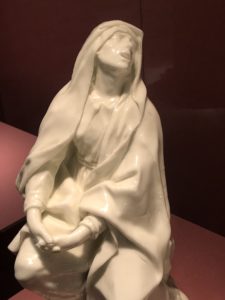

For our first artwork, I want to introduce you to Giuseppe Gricci‘s, The Mourning Virgin and Saint John The Evangelist. This beauty is made of soft-paste porcelain and was made in Naples, Italy in 1744. They’re very small so I want you all to get close to closely see it. As you can tell from the name of this piece, this depicts the Virgin Mary after the death of her son, Christ, and Saint John right next to her. The way Giuseppe portrayed them in their mourning is just impressive and it’s almost like the material that they were made out of captures the mourning even better. We should first focus on the Virgin Mary’s face. Her head is tilted up with her mouth open and her eyes. Then, we also see her body language, she is then propped up on one knee as if her grief has taken over her. When we look over at Saint John, his body is turned away from the Virgin but his head is facing her. Almost as if he is in shock at what had happened and also feels shame. The drapery that is shown almost makes it look like as if they are in movement. The white porcelain makes them look so fragile from their grief. From the emotion on their face to the material that they are done out of, Giuseppe successfully shows the aftermath of Christ’s death that is filled with horror and sorrow from the ones who followed him. In this case, Giuseppe used his material to emphasize the pain St. John and the Virgin Mary felt. This is a perfect first demonstration of emotion and the emotion of a story being shown in art. The sadness is already apparent before you even know any context behind it, and that ladies and gentlemen is very powerful in itself.
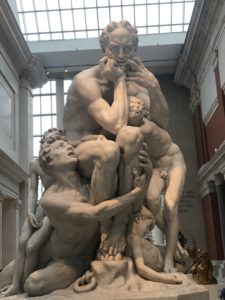
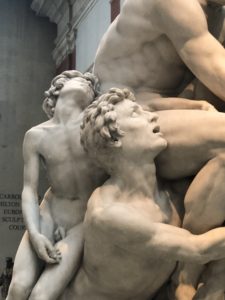
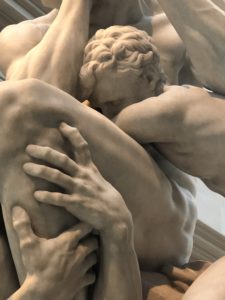
This next masterpiece, is called “Ugolino and His Sons” created by Jean-Baptiste Carpeaux. It is made of Saint-beat Marble and was made in 1865-67, Paris. The name of this artwork is not as revealing as the first work of art that we looked at, so I want you analyze this statue deeply and try your best to look at every single detail. It is very obvious that the man in the front, Ugolino, is in extreme anguish. You can see his knotted body and the way he has his fingers in his mouth. On top of his anguish, it’s almost as if he is indecisive about something. If you focus on the kids around him, his sons, they all are around him either laying on him, hiding in his body, or clinging to him. We see three of them either asleep or maybe even dead and the one who seems to be the older one is the only one looking up at him in some sort of desperation. We see that they are suffering and it comes across very loud and clear. The story behind this statue comes from the epic poem, Dante’s Inferno.Dante encounters Ugolino and his sons locked in a tower after Count Ugolino betrayed his city, Pisa, by giving away fortresses to other towns. When locked away, his sons were complaining about being hungry. When mealtime came, he noticed the door was being nailed. That is when he realized that he would starve in that tower with his sons and other sinners. Driven insane from starvation and seeing his sons slowly die, Count Ugolino was faced with no other choice but to become a cannibal. In some stories, it is said he ate the bodies of his sons and in others it is said he continued to starve. I chose this to be apart of the tour because it is a piece of art that only intensifies the emotions you feel after you hear the story. You experience their emotions before knowing anything about it and pick up on their horror. You notice their facial expressions and their body language but do not know why. Once you find out, you can’t help but feel even more horrified. Carpeaux is just another artist that has managed to envelop you before and after you hear about his inspiration.
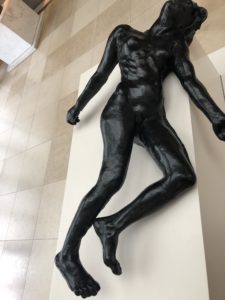

The last statue we will be looking at today is called “The Martyr.“This bronze piece was made by Auguste Rodin in 1898, France. This is another work of art that’s name really gives away the story behind it. However, I want you all to look at her body language and forget about her facial expression. Her body language really gives away her suffering. Whenever we see an artwork of death, we typically see them lied down flat, but here we have something different. We see her arms spread wide, her legs are at a weird angle, and her is almost hanging off the altar she is put on. We can safely conclude that she suffered a great deal of pain before her death. A martyr is someone who is killed for their religious believes and the deaths of the Apostles serve as a testimony that these deaths are very morbid and gruesome. Rodins, “The Martyr” shows that she comes a “symbolic martyr to humanity‘s shard fate. Her youth evokes death‘s universality, her nakedness its indifference, and her isolation the loneliness of the final struggle.“This artwork can compare to Carpeaux‘s “Ugolino and his Sons” because of the decision to express emotion through body language. We hear her tragic ending being told by the way she is positioned on this alter. Although her face does give off a lot of emotion, her body is the statement. The title of this work, her body language, and her bodies symbolism all come into one to tell her tragic tale.
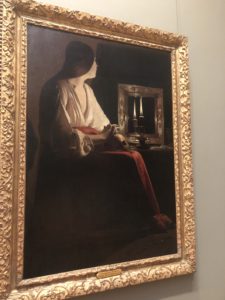
This painting is called “The Penitent Magdalen.” This oil on canvas was made by George de La Tour in 1593-1633, France. Mary Magdalene is known for being the personification of christian fidelity. It is said that Mary Magdalene was a Jewish women who followed Jesus to the death. When Jesus was set to die on the cross and his men abandoned him, Magdalene stayed by his side. She is said to be around him at his tomb and to be the first to announce his resurrection. As you can see, this is the first work of art that does not show a face. Her head is turned away, and we are left to only work with her body and the objects around her. We see a skull on her lap, her hands crossed, a mirror and a candlelight. It is said that Mary Magdalen “renounced the pleasures of the flesh for a life of penance and contemplation.“The mirror is a symbol of”vanity“, the skull on her lap is an “emblem of mortality“, and the candle light most likely stands for her “spiritual enlightenment.” If we moved on to focus on the colors of this painting, the only thing that is lighted from the candle light is the top of her robe. The rest of the painting is filled with shadows and dark colors. We look at this painting and keeping all in the information in mind, we pick up that this an hour of solemnity. This is contrasts from all the statue work we have seen today, but still falls in line, because although we don’t see a face, we are still giving enough objects to grasp the emotion of this painting. Her hands, the skull, the mirror, and the candlelight are enough to give us what we need to understand the sentiment of this painting.
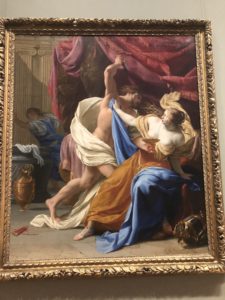
For the last artwork of this tour, This painting is called “The Rape of Tamar.“This oil on canvas was made by Eusatche Le Seur in 1614. This graphic scene tells the story of Tamar being raped by her half-brother Amnon. In the bible, II Samuel 13:1-22, Amnon was a son of David and fell inlove with Tamar. He convinced his friend to help set up a plan which consisted of Amnon faking a sickness and ordering that Tamar attend to him. When they were alone, he turned on her and raped her. After realizing what he had done, he sent her out of his chamber.When Tamar‘s brother, Absalom, realized what had happened, he had Amnon killed. Of course, the face of Tamar and Amnon really gives away the horror and chaos of the scene, but I want you to focus on what is going on in the rest of the painting. From behind them, we see a figure walking away, which we can guess is the friend. He could depict the betrayal that happened here. On the floor, we see objects fallen over. Notice also the movement that is in this picture. The robes of the man in the back are behind him. The white drape of Amnon is also all behind him, only covering his privates, the top of Tamar‘s dress has the same type of movement. Her hair is also in mid-air. Le Seur literally paints this scene in mid-moment right before the rape happens. By doing this, Le Seur accurately shows the chaos of this scene, and he does it in more than one way. He uses all of his canvas to his advantage to set this violent act in motion. The little things do matter in this painting. In taking in all of these things, we feel for Tamar because of the betrayal and the impulsiveness that comes from Amnon. With a painting like this, knowing the story is only the beginning in experiencing the horror of this act.
Well ladies and gentleman, I really hoped you all enjoyed this short tour. It has been a pleasure taking you around the MET and showing you some of my favorites statues and paintings. I hope you were enammored by the different stories and emotions shown just as I was when I first learned of them. Feel free to roam around the rest of the museum and see what other stories you may find. Have a great day and enjoy the rest of your stay.



